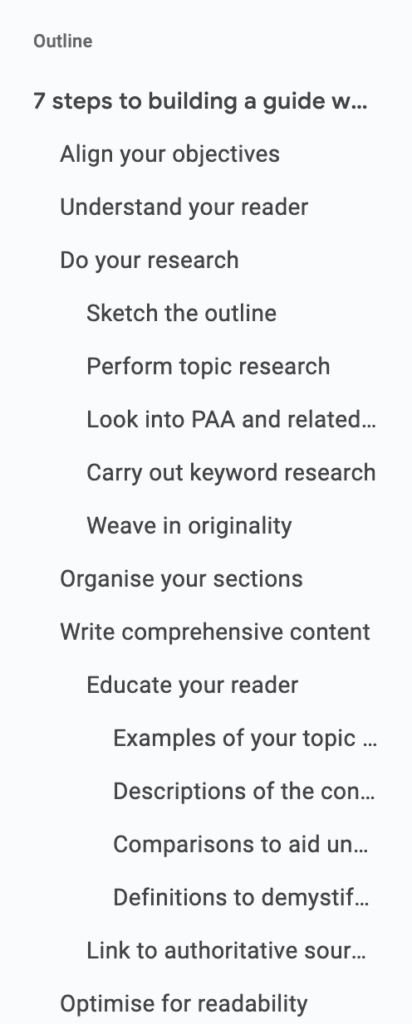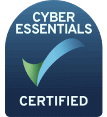Creating guides for your website does not just provide benefits for your readers, who will view your brand as an authoritative resource – it also helps immensely with adhering to Google E-E-A-T guidelines.
Google has made it clear that quality content is one of its ranking criteria, and the search engine has indicated that copy which showcases experience, expertise, authoritativeness and trustworthiness will be given priority in the SERPs.
High quality guide content is inherently comprehensive, and these pieces should be written by an expert who can provide original insight. Such content will not only assist with rankings, but it will also be priceless for your reader.
If you want to create guide content that will stand out from the crowd, follow this 7-step process to build out comprehensive and profitable cornerstone pages that will prove to be high-quality assets, time and time again.
1. Align your objectives
The first step you want to take is ensuring you know what objectives your guide is going to achieve.
Overall, you want to educate your audience by giving them an introduction to a topic or subject.
You will be effectively taking them by the hand and walking them through a step by step process, sprinkling in original insights and tips along the way.
Specify a set of actions, or particular goal, you want to empower the reader to achieve by the time they have finished the guide.
They should walk away with a new set of knowledge and the ability to do something they couldn’t before.
At the core of any high quality guide is the objective of teaching new information.
However, you want a truly effective guide to target your level of understanding, use language you are comfortable with and guide you towards taking the next step on your journey of exploration within this topic.
2. Understand your reader
There is little use in creating a longform piece of content, such as a guide, which does not have a marketing persona in mind. You are effectively taking a gamble and seeing if it pays off.
Instead of wasting your time creating content which may not resonate with the people you want to engage with your brand, ensure you have a marketing persona to hand before you begin researching your guide.
Once you have this information, whether you get it from your sales, marketing or business colleagues or gather the data yourself, you will be able to apply it to some key questions which should be asked before you start any research.
You want to know how much knowledge the marketing persona should already have on the topic. If you make the content too simple or too complex, you will lose them almost immediately – and the only contribution you will be making to your site is towards the increased bounce rate.
You also want to establish what they do not know about the topic. You can gather this information by asking your existing customer base directly about their current pain points, or by performing keyword research to identify informational keywords with a decent level of monthly search volume over time.
3. Do your research
Sketch the outline
You will likely already have some initial ideas about how the outline of your guide will look. Sketch these out on your page and create an outline which includes everything you believe the guide should include.
From there, you will want to ensure your guide incorporates all of the information readers want to know about the topic, as well as sections your competitors have included – and original insights you can contribute based on your own experience, as well.
Perform topic research
To get started, perform some topic research on Google and find out what the top articles are covering. Make a note of the structure each competitor follows and weave any sections you missed into your outline.
If you spot any useful keywords that regularly occur, ensure these are incorporated into your outline. You may like to assign keywords you discover at this stage to specific sections, so that you know when and where to target them.
Look into PAA and related queries
Another step to take at this stage is to analyse the People Also Ask section in the SERP, as well as related queries at the bottom of the page.
These sections can provide additional information to weave into your outline – with the added bonus that, if you make your own version more authoritative, you could win yourself a featured or rich snippet upon publication.
Carry out keyword research
Once you have an understanding of the competitor landscape, turn to your keyword research tool and dig into the queries readers are plugging into search engines when they want to learn about your topic.
Because you’re writing a guide, you want to isolate informational keywords. If you find useful related keywords that could be applied to tangential content in the future, make a note of these and sketch out when you will write this supporting content to build out your topic cluster.
Weave in originality
Now that you have covered the competitor and keyword bases, it’s time to ensure your originality is weaved in. Make sure you are applying original tips, tricks, shortcuts and advice where relevant, as well as insider knowledge you have picked up – especially if it hasn’t been widely talked about by your competitors.
You can also include anecdotes to personalise the piece further and drive home the fact you are an expert on the topic, building the reader’s trust with you as the author.
4. Organise your sections
Now is the time to return to your skeleton outline and build it out more thoroughly. You want to ensure the backbone of your guide is well-organised, as if it is lacking structure you run the risk of creating a messy piece that doesn’t achieve all of your objectives.
You may find it useful to apply the relevant header tags at this stage so that you can check through the structure as a whole with ease, ensuring that you have not duplicated subtopics, skipped any steps or placed any sections in the wrong order.
For example, if you are writing in Google Drive, you can structure your document with the relevant headers and open an overview in a panel on the left to understand your overall structure and make amends.

Ensure your main title uses a H1, sub topics use a H2 and that, where relevant, you use H3s to split out individual points within your sub topics.
By getting this structure down now, it will be much easier to build out your guide cohesively and thoroughly as you enter the writing stage.
5. Write comprehensive content
Guides are in-depth and comprehensive by their nature, so now that you are ready to write the content, you want to ensure you give it 100% of your effort.
Educate your reader
When you dig into your topic, do your best to educate the reader using methods such as:
Examples of your topic in practice
You could describe your own experience, include screenshots for visual readers and include your tricks and shortcuts, learned from your own experience, to enhance the reader’s journey.
Descriptions of the concepts
You can engage the senses here by describing how something looks, tastes, feels or smells. You will not only provide more vivid and engaging copy by doing this, but you will also be proving that you have had first-hand experience of the topic and should be considered a trustworthy source as a result.
Comparisons to aid understanding
If you are introducing a new concept which could take time or effort for the reader to comprehend, compare it to a real-life concept that they will easily be able to relate to.
Definitions to demystify jargon
When you need to introduce new terminology, ensure you explain it in detail using simple language so that your reader is set up to reference this information and apply it as they continue to read through the guide.
Link to authoritative sources
There will be points in your guide where you can link to other authorities on your subject, particularly when you reference a related topic but do not have the space to explore it in depth in your guide.
By providing a link from an authoritative source, you are adding value to your own content by building out a network of information that the reader can explore to widen their knowledge further.
Links will also be necessary when you are making a claim that needs to be backed up with evidence. For example, if you are quoting a statistic, you will need to link to the original source to back it up.
Choose your source link carefully. Instead of choosing another third party which is quoting the original, put the effort in to find that original – even if it takes a little time to do so.
After all, the reader will want to find out what the original information was, not be directed to a page that is similar to yours. Think about the user when you are linking out and ask yourself which sources would provide them with the most value.
6. Optimise for readability
Once your content has been created, ensure you self-edit and proof before passing on to a trusted colleague or friend for a sense check.
At this stage, you will also want to ensure the copy is optimised for readability. As a general rule of thumb, your content should have the following features:
Engaging opening paragraphs
The reader should receive confirmation that the guide will be comprehensive and answer all of their questions, plus more.
Jump links to individual sections
As guides are longform pieces of content, including jump links allows for the reader to easily navigate between areas of particular interest.
No long paragraphs
Stick to just a few sentences per paragraph, and break up the copy to ensure there is enough white space and no walls of text. Bulletpoint lists can also help to break up copy.
No use of jargon
Avoid using terminology or complex language. When you are explaining a new concept, word or phrase, be sure to explain it in plain English for your readers.
7. Ensure SEO best practice is applied
When you are writing genuinely useful content, you want to focus on the content itself as opposed to shoehorning in keywords. However, there are steps you can take afterwards to ensure your guide is optimised for receiving organic traffic. Here are a few:
Keywords in subheadings
By applying the relevant keywords to each of your subheadings you are helping both search engines and readers find the information they need to understand your piece.
Internal linking strategy
Ensure your piece links to other content across your site that is relevant and that your readers will find useful as they continue exploring your site.
Good meta description and title tag
When a prospective researcher is deciding which page in the SERP they are going to click on, they will pick the link which appears to provide the most authoritative answer to their query. Ensure your meta description and title tag summarises your guide effectively and guarantees their query will be answered in detail.
Want to write better guides?
If you want to create better guides, but you are in need of some assistance to ensure they receive the organic traffic they deserve, we can help you to build out these pages for SEO.
To find out how your existing guides are performing and where you can improve, book in for a Free Acquisitions Workshop and benefit from expert advice and actionable insights you can apply right away.












